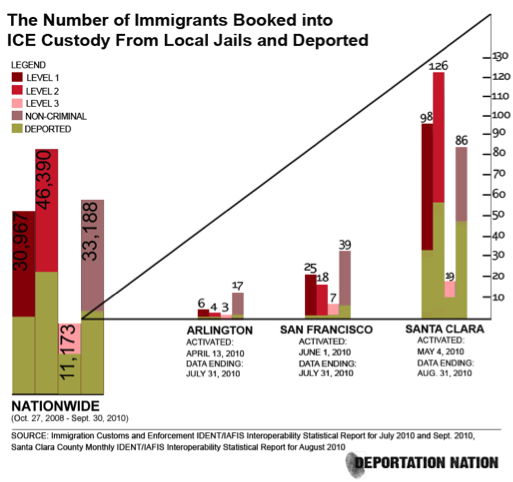When a single-mother of three got into a car accident while driving without a license in Hayward, California, she met a fate common to undocumented immigrants.
"A police officer told me he needed to take me to the police department where my fingerprints would be taken, said the woman, who shared her story with Deportation Nation by way of Somos Mayfair, but asked to remain anonymous.
While she was at the jail, Immigration and Customs Enforcement (ICE) agents saw her prints in the state DOJ database. She now faces deportation and the question of what to do with her children, who are all US citizens.
Stories like this have become common, but counties that feel forced into the data-sharing partnership called Secure Communities are exploring ways to avoid them. A key place to watch is Santa Clara, a California county of 1.8 million, where a third of residents are foreign-born.
Even though Secure Communities has a mandate to target dangerous immigrants, recent data available for Santa Clara County shows non-criminals account for 26 percent of those transferred into ICE custody, and 34 percent of those deported. (see graph)
This rubs salt in the wounds of Santa Clara officials, who made it clear to ICE that it wasn't interested in the program but got enrolled anyway this past May.
So shortly after Homeland Security Napolitano told reporters, "we do not view this as an opt-in, opt-out program," the county went ahead and sent its opt-out letter. Now a meeting with ICE to discuss the request is scheduled for November 9.
In the meantime, Santa Clara's Board of Supervisors has asked the county counsel to look into other possible actions.
"I think some local governments are starting to feel painted into a corner. We don't want to have to make our own determination about who is worthy of being held for ICE and who is not," said Anjali Bhargava, Deputy Counsel for Santa Clara County.
Bhargava is researching whether the county can ensure that "funds are only used to comply with requests by U.S. Immigration and Customs Enforcement to the extent they are subject to reimbursement or required by law." This would apply only to the Sheriff and Probation departments, but not to the 15 city police departments in the county.
On a recent day the county's Department of Corrections held 375 immigrants in its jail at the request of ICE, most of whom would be held the full 48 hours before federal agents picked them up. This means it could incur the costs of an additional 18,000 hours of detention, none of which would be covered by ICE.
Other counties have looked for ways to put limits on the fingerprints sent to the state's database, which is monitored by ICE. This has been done in El Paso County, Texas, where the sheriff says he only shares fingerprints from Class B misdemeanors and above. This may not be allowed by California Penal Code.
But one thing county officials can control, is their budget. Depending on how ICE responds to its concerns, Santa Clara County may refuse to spend county resources detaining people on ICE's request.
"That option is certainly still on the table," said Bhargava.
Editor's note: This story has been updated for clarity.
This story originally appeared on Deportation Nation, a news website dedicated to covering the expanding merger of immigration and local law enforcement.
